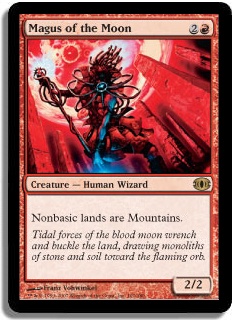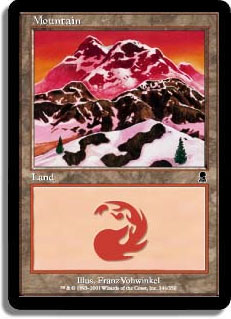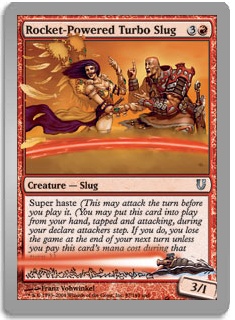The StarCityGames.com Open Series is rolling into the Seattle area on the weekend of July 23, and one of the guests of honor is Magic artist Franz Vohwinkel. The German-born and now Seattle-based Vohwinkel is a remarkably prolific sci-fi and fantasy illustrator who’s helped shape the look of many franchises, including Dungeons & Dragons, Warhammer, MechWarrior (part of the BattleTech universe), and Magic: The Gathering.
A Magic Arcana shows a picture of Vohwinkel at Gen Con 2008; if you can’t see it at work, it’s best summed up as “spiky ash-blond hair, spiky tip-of-chin beard, single earring, rectangle-lens glasses, funky watch, slightly off-kilter patterned black-and-red T-shirt.” He looks similar (if less spiky) in this picture from 2010 Grand Prix Portland. On the Magic Illustrator Measure of Signing Appearance, where 1 is the deceptively normal Dripping Dead illustrator Thomas M. Baxa and 10 is my sole memory of Terese Nielsen (whose MIMoSA factor of 10 has zero bearing on how incredibly friendly and patient she was with the awkward college-freshman version of me), I rate Vohwinkel’s appearance at a 5.
Vohwinkel made his Magic: The Gathering debut in the summer of 1997 with two cards in Weatherlight, Fervor and Goblin Vandal, though most of his 1990s work for Wizards of the Coast was on the sci-fi BattleTech CCG, which saw print from 1996 to 2001.
With the end of the BattleTech CCG imminent, Wizards of the Coast found room for him among Magic’s illustrators; the shift took place as Magic creative was shifting from Masques block to Invasion block, and the battle-suited Urza and other near-sci-fi concepts in Invasion block doubtless eased the transition.
It was a smart move: Vohwinkel’s main run of Magic illustrations began in the autumn of 2000 with two cards in Invasion, Keldon Necropolis and Pledge of Loyalty (aka the Tin Can Hit Man), and he has been a steady presence in the game ever since.
Like a number of other Magic artists, Vohwinkel has made the shift from physical paint to digital creation; per Vohwinkel’s website, his Blood Moon was done in oils, while Magus of the Moon was rendered with Corel Painter. Painter is designed to simulate the act and look of physical painting, which explains how Jotun Grunt can look so much like a traditional painting even though it’s a piece of digital art.
Vohwinkel has had 89 Magic illustrations appear on 88 cards, 87 of them in buy-and-open printings. (The discrepancies come from split card Fire / Ice and the FNM promo Krosan Grip, respectively.) He is one of the most flexible Magic artists, capable of rendering static artifacts, the frenetic action of instants, and stunning landscapes with seemingly equal deftness.
That versatility can make it hard to remember what he’s done, though. To help you sort through your collection and pick out your Vohwinkels to get signed, I’ve organized his cards into four groups: Standard-legal, (loosely) competitive cards in older formats, casual favorites, and “the rest.” Don’t dismiss “the rest” out-of-hand; you may find a favorite artwork among the leftovers.
On to the art!
Standard-Legal
Buried Ruin – The jury is out on whether this will see Standard play, but in the meantime, it’s a cool landscape, and somebody’s going to love it for an artifact-centered deck.
Copper Carapace – Straight-up Limited fodder, but the art is kind of cool to me, and if I rate it “kind of cool,” maybe it’s your favorite.
Expedition Map – Saw play in the earliest versions of Valakut but has largely fallen by the wayside. It still has a place in certain builds of Eldrazi Green, though, and I know at least one Magic enthusiast who’s obsessed with cards showing maps…
Flight Spellbomb – All the Scars of Mirrodin Spellbombs are Vohwinkel projects. Flight isn’t the most played Spellbomb in Standard (there’s Panic Spellbomb to contend with), but never count out a cheap, cantripping source of evasion.
Glacial Fortress – Caw-Blade may be gone, but Puresteel Paladin and other U/W decks mean that this core-set dual will be in demand until at least fall 2012. This is a staple card by now, and you won’t be parting with your set anytime soon, so get them signed and make your Standard decks that much more awesome.
Horizon Spellbomb – Totally outclassed for now by the amazing range of mana-fixing in Zendikar block, but when Innistrad replaces Zendikar, this Spellbomb’s time may come.
Kazandu Refuge – Are there better duals out there? Of course! But in its short history, Kazandu Refuge has been reprinted in Archenemy and Commander. More a casual favorite than a competitive card, it is Standard-legal, at least for a little while longer.
Khalni Gem – Sorry, all you Khalni Gem fans out there; the Vohwinkel art is the best part of this card.
Mountain (Odyssey) – Most Magic artists eventually get their turns at basic lands, and Vohwinkel is no exception. Get into those dusty boxes labeled “Odyssey” and raid the basic land draft boxes of card shops you don’t like because I want to see signed Vohwinkel Mountains casting burn spells when I tune into SCGLive.
Myr Battlesphere – Right now it’s more of a Limited bomb than a Constructed finisher, but that could change if a Grand Architect—Quicksilver Amulet or similar deck emerges in post-Zendikar Standard. In the meantime, we can hold out hope for a plushie Myr Battlesphere like the Perilous Myr plushie. It’d be a big ball of cute!
Nihil Spellbomb – So I’ve heard the odd rumor that Innistrad is a graveyard-themed set. If so, Nihil Spellbomb is going to see lots more play. Get your set signed now.
Oblivion Ring – Despite appearances in Archmage, Commander, and Planechase, the O-Ring (stretches to exile any other annoying nonland permanent) was not Standard-legal for about nine miserable months, but it’s back, baby! Oblivion Ring will be a staple for as long as it’s in Standard, so get these signed. (Just make sure you don’t grab any copies from Lorwyn by accident. He didn’t make that art, and there are few things more awkward for an artist than having to say, “Uh, I didn’t illustrate this one.”)
Origin Spellbomb – David Shiels proved this card was Standard Open Top 8-worthy by making it a three-of in his Tempered Steel deck from Cincinnati. It’s well worth keeping in mind if you’re taking the archetype to Seattle.
Ornithopter – Come fall and Innistrad, Ornithopter will be out of Standard, but you still have time to work with this popular component of Kuldotha Red and Tempered Steel. Why not do it by playing with signed copies with Vohwinkel’s Magic 2010 and Magic 2011 artwork?
Overgrown Battlement – This seemingly innocuous mana-producing wall from Rise of the Eldrazi has picked up enemies as well as friends during its stint in Valakut decks. Time is running out for Overgrown Battlement in Standard, but its flexibility makes it a prime candidate to stick around in popular casual formats and possibly Extended as well.
Panic Spellbomb – The red-cantrip connection has made this Spellbomb a popular choice for Kuldotha Red pilots, and it’s maintained a tenuous hold on that status even as other, cheaper artifacts have filtered into the Standard metagame—largely for the “Oh, hello, Mr. Phyrexian Obliterator, I’d rather you didn’t block this turn” factor.
Phyrexia’s Core – Eh, the streak of Standard carts that see play in Standard tournaments had to end sometime. The card’s art is vastly better than its mechanics, though, falling somewhere between abstraction and landscape.
Pitfall Trap – Most competitive Standard players spotted this Trap early on and avoided falling into it. The strong lines are really reminiscent of Phyrexia’s Core, which I like.
Razor Boomerang – Strictly Limited fodder for now, but if you’re a fan of Zendikar block’s habit of inflicting terrible fates on Minotaurs (see: Smite), this is your card!
Runeflare Trap – This was more a card for Howling Mine times than Temple Bell times, but at FNMs across the country, people are still trying to make Runeflare Trap work, and to them, I say keep it up as long as you’re having fun!
Seer’s Sundial – Never quite fulfilled its promise of getting land-flooded players back into the game, but at least it looked pretty in the uncommon slot as players cracked packs of Worldwake and thumbed to the end to check for Stoneforge Mystic and Jace, the Mind Sculptor.
Sphinx-Bone Wand – The card is more suited to the haymaker style of Commander than the lean decks of Standard, but the art has a great presentation: simple case, exotic artifact.
Voltaic Key – Vohwinkel’s Magic 2011 art is more overtly digital than most of his illustrations, but it works in the context of this Swiss Army knife of an artifact.
Warlord’s Axe – Cast aside for Greatsword in Magic 2012 and never broadly adopted for Standard play, but Vohwinkel’s penchant for unusual perspective gives the dramatically angled artwork plenty of punch.
Older Competitive
Blood Moon – Between Dragon Stompy and the newer U/W/R deck styles with Blood Moon and its Magus, this nonbasics suppressor still sees plenty of play. Get your Eighth Edition and Ninth Edition versions out and get them signed. Bonus points if the Ninth Edition cards are in Russian.
Earthquake – So long as there is an Elf deck, this will be the “Ha ha, dead elf” tool of choice for scoring lots of points at once. Dig out your Seventh Edition copies and get thee to the signing line!
Fire / Ice – This split card never goes out of style for the decks that can support it. I loathe playing against this card—loathe, loathe, loathe it. Of course, “loathe” turns to “love” when you’re on the other side of the table…
Glassdust Hulk – An essential part of the balanced Living End or Open the Vaults deck.
Jotun Grunt – My only signed Vohwinkel card is a Grunt; I got lucky and received one as “Slightly Played” from StarCityGames.com (occasionally, very occasionally, you can win the “signed = Slightly Played” lottery thanks to that policy). If you’re playing white, in the market for a graveyard disruptor, and a fan of 4/4 creatures for two mana, look in your Coldsnap and Commander boxes and see if you can scrounge up a set to get signed.
Magus of the Moon – If you’re getting Blood Moon signed, by all means seek out four copies of its Magus.
Shard Volley – Sure, it’s no Lightning Bolt, but when you have enough Lightning Bolt simulacra, you can deal with lots of drawbacks. Morningtide wasn’t the most-opened set, but fortunately this is a common.
Snow-Covered Island – The Coldsnap edition is a Vohwinkel, and as long as Gifts Ungiven sees play, there is incentive to run at least one Snow-Covered Island alongside non-Snow counterparts.
Sword of the Meek – Do you like Thopter Foundry? Do you like gaining a life and making a 1/1 flying creature for one mana? Do you like cards that are banned in most rational formats? Then get yourself a Sword of the Meek! Remember: your opponent will be in twice as much awe of you as you execute your combo if the Sword of the Meek is signed.
Time Sieve – This one lingers in the “competitive” realm mostly on its past play, but if an Open the Vaults deck becomes a contender in a future Extended/Modern/Overextended deck, Time Sieve almost surely will play a part.
Wargate – It may not play nearly as well without Prismatic Omen to back it up, but this is still one of the most powerful onto-the-battlefield tutors ever printed. Show it some love.
Casual Favorites
Preface: I probably left out your favorite, and I apologize. This is simply a list of cards that I’ve seen played casually to varying degrees.
Akki Underling – My list, my pet Samurai deck, my Akki Underling. It would’ve been easy to turn the Underling into a comical figure, but by rendering it as earnest, Vohwinkel makes it much funnier—and a little creepy.
Armillary Sphere – This basic land-fetching artifact is gone from Standard but far from forgotten, as its reprinting in Commander proves.
Broken Ambitions – I disliked this card when it was in Standard and a counterspell of choice for the Faeries deck. Now that it’s out of my tournament life, I appreciate it much better.
Ceta Sanctuary – It’s been a long time since I’ve seen this one used in kitchen-table play, but I wonder how it would interact with hybrid cards.
Darigaaz’s Caldera – Along with Dromar’s Cavern (another Vohwinkel artwork) and the rest, the Lairs from Planeshift defined “good tri-land” until the arrival of Alara block. They still see limited play in casual formats, especially those with Highlander construction rules.
Dispeller’s Capsule – A slightly off-kilter artifact version of Seal of Cleansing, useful to remember whenever building a deck that can tutor for artifacts.
Dromar’s Cavern – My favorite art of all the Planeshift Lairs. It’s practically mesmerizing.
Esper Panorama – Part of me is disappointed that the Panoramas, including the segmented-sky Esper Panorama, received plane-specific names because that makes them less likely to be re-used in the future. Of course, theoretical reprintings hardly matter to Commander enthusiasts and other casual-multiplayer fans; only actual printings matter.
Evacuation– Vohwinkel’s pieces-on-a-board motif, perhaps the most metafictional a Magic card has gone outside an Un-set, appears on a Duels of the Planeswalkers promo card in addition to the most recent core set printing in Tenth Edition.
Fervor – Improved upon by cards such as Mass Hysteria but not entirely supplanted or obsolesced, Fervor has been fueling my dreams of Sheltering Ancient / Cosmic Larva / you-get-the-picture decks for as long as I have known about it.
Goblin Mime – The Un-sets aren’t for everyone, but the foil’s box around the mime? Priceless.
Goblin Vandal – Is he the most efficient artifact removal? Hardly. He’s also a Goblin, though, which scores points with a large set of Casual players.
Insist – Whether it’s Iona, Shield of Emeria or MC Hammer, can’t counter this (na na nana nana, nanananana), can’t counter this!
Izzet Steam Maze – If you’re going to get a casual card signed, why not go big with this Planechase plane? I’m imagining a silver Sharpie signature at the bottom left of the artwork…
Keldon Necropolis – Part of the block-spanning mega-cycle of legendary lands, the Necropolis may not be fast, but it is an uncounterable source of burn, provided you have the creatures. But most of the creatures can be countered. Dilemma! It’s one that kitchen-table players have been trying to solve for years.
Lithatog – The only recognizably female Atog also happens to be into piercings, it seems. That, and sacrificing artifacts and lands. I wonder how the various Atogs interact with Fresh Meat?
Molten Influence – Let your spell get countered or take the pain. While the opponent’s ability to choose the less painful option makes this card weaker than it might be, the idea of a red counterspell is still enough to send certain types into a Vorthos-fueled tizzy.
Rocket-Powered Turbo Slug – Admit it. You want to see “Super haste” as a legitimate mechanic in a future block. Hey, if The Cheese Stands Alone can turn into Barren Glory, anything is possible. Just ask Kevin Garnett!
Rowen – I have to be honest; I prefer the Visions – Classic Sixth Edition artwork. That said, if you’re a fan of the 7th Edition version (which certainly isn’t bad by any means), pull yours out, hop in line, and get them signed!
Scattering Stroke – A Mana Drain toned down for modern times, but still plenty fun enough to get reprinted in Commander after its stint in Lorwyn.
Scepter of Fugue – It doesn’t dovetail nicely with the “wild-and-wooly” ethos of many multiplayer formats because it breaks the rule of “let others cast what they will (and if you counterspell, do so fairly).” That said, sometimes you just have to bring the grief, and the Scepter does, turn after turn.
Sludge Strider – This creepy-cool creature never took off in any competitive format, but it sure fires the imagination, which helped it get a Planechase reprint.
Twinning Glass – I’ve tried to break this card dozens of times, and it’s always broken me. I still haven’t given up hope…
Virulent Sliver – The SCGLive team doesn’t have Jacob Van Lunen in the lineup for Seattle, but maybe Gavin Verhey or Brad Nelson will spare a thought and get a copy signed for the Sliver Kid.
“The Rest”
These are all the other Magic cards Franz Vohwinkel has illustrated and that I know. You may find cards here that you expected to see elsewhere; perhaps you pilot a rainbow-style deck and were wondering where your powerhouse creatures, the five-strong Mimic cycle from Eventide, were hiding.
Battlegate Mimic
Chronomantic Escape
Coordinated Barrage
Dire Undercurrents
Forfend
Heat Shimmer
Helionaut
Helm of the Ghastlord
Keldon Twilight
Mirror Golem
Mistform Wall
Moonwing Moth
Morgue Toad
Nightsky Mimic
Pledge of Loyalty
Puncture Bolt
Resplendent Mentor
Revelsong Horn
Riverfall Mimic
Serpentine Basilisk
Shade’s Breath
Shorecrasher Mimic
Soratami Cloud Chariot
Symbiotic Beast
Thermal Blast
Woodland Changeling
Woodlurker Mimic
I hope you’ve enjoyed this look at the art of Franz Vohwinkel, and if you’re attending the StarCityGames.com Open Weekend in Seattle, that you’ve been inspired to dig through your card boxes and find some goodies to get signed.
As always, thanks for reading.
— JDB
@jdbeety on Twitter









